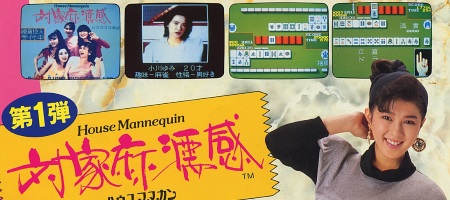It’s interesting perhaps, that while the majority of arcade Mahjong games are 2p VS types, most are in reality single player games. Of course there’s a simple explanation for this, the game relies on the players not being able to see eachothers tile hands, just like poker for example. Nichibutsu did actually come up with a solution for this, and released a couple of games using a special LCD system. One of them is House Mannequin:
As you can see from the flyer, they built LCD screens into the two control panels. You don’t see either players hand on the monitor, just discards, dora tiles and other game information. Instead these are displayed on the LCD screens above the keys. I’ve not been able to find out how common these cabinets were, but I’ve only seen one instance of the hardware, which I’ve bought.
First up is the game PCB, the pinout is actually the old standard with no real modifications of note, however there are two extra connectors which drive the LCD displays, along with a contrast control. The edge connector could be in better condition, but overall the PCB is in excellent shape.
Here’s the first control panel, it’s in the worst condition of the two and has a blown inverter (more on that later) so I had to borrow the part from the second panel for the running photos. It was also disgustingly dirty with decades of nicotine, coffee and coke getting into every gap it could find. It’s also been sat in the sunlight which has affected the colours.
The second panel is in much nicer condition, you can see the difference in the colours straight away.
The set also came with both instruction cards and a manual, but the manual turned out to be for the wrong game and didn’t even have correct wiring in it. Oh well. Again you can see one of them was exposed to the sun.
As mentioned, the first panel wasn’t completely working and incredibly dirty, and I ended up having to basically strip it to components, you can see what we’re dealing with in the photo below.
Lovely…. The only way to clean them was basically by hand. Every single key had to be cleaned by hand, the membrane parts had to be cleaned by hand, the button plastic cover needed all the inner edges doing with cotton buds and so on. I hated every moment of cleaning it.
Here’s the control PCB, some of the pads were slightly corroded too, but thankfully cleaned up well enough to work reliably. That white block is an inverter, it turns 5v DC into 110v AC to drive the EL panel which forms the LCD backlight. It’s also dead. Fortunately EL panels and wire are really popular at the moment and I’ve found a 5v USB inverter which drives a panel of the right size, just waiting for a few connectors to fit it properly. I’ll have to upgrade both of course otherwise the brightness will be different between panels.
Here you can see the control PCB and panel PCB refitted in the control bin, it’s quite fiddly to re-assemble.
The finished panel. It’s a shame about the sun fade and the fact that some dirt has crept into micro cracks in the plastic laminate, hence the dirty shadows around the edges. I’d have to get the art remade to fix that.
Since I didn’t have the manual, I had to look up some games which used the same LCD panel system, and Shou found a shop which let him take a photo of the wiring diagram for me – very useful since at the time I had no way to work out what voltage the inverters expected! I’ve since found a genuine manual for one of the other games which is on the way.
When you start the game up, this is the screen you’ll see, yes it does contain stripping women, but it’s very tame – “sitting next to a piano with no shirt on” level stuff.
The panels will display the game over screen, and cycle through game and company name screens.
And finally here’s what the whole system looks like during play – it’s hard to photograph the panels well, they’re actually a uniform contrast when you see them in person. This is with the game in real 2 player mode of course. Sorry the game doesn’t actually match up with what’s on the panels, I was struggling for space on the workbench and had to take photos of the control panels hooked up one at a time.
So there we have it, quite an unusual piece of hardware which is probably new to most people. I’d like to find a complete cabinet if I can, but for now it’s nice to own a working setup, I can’t imagine there are too many left now.

















